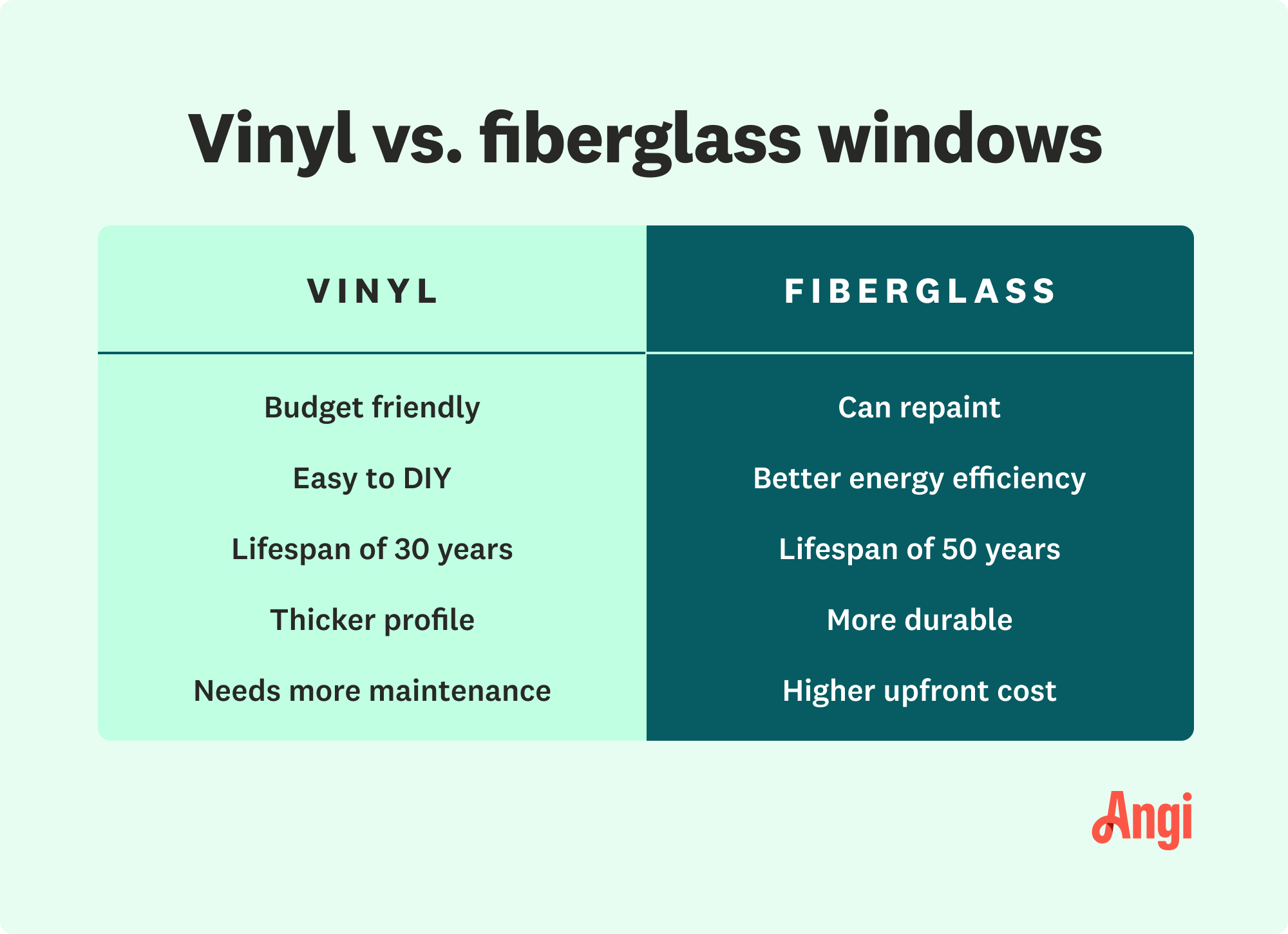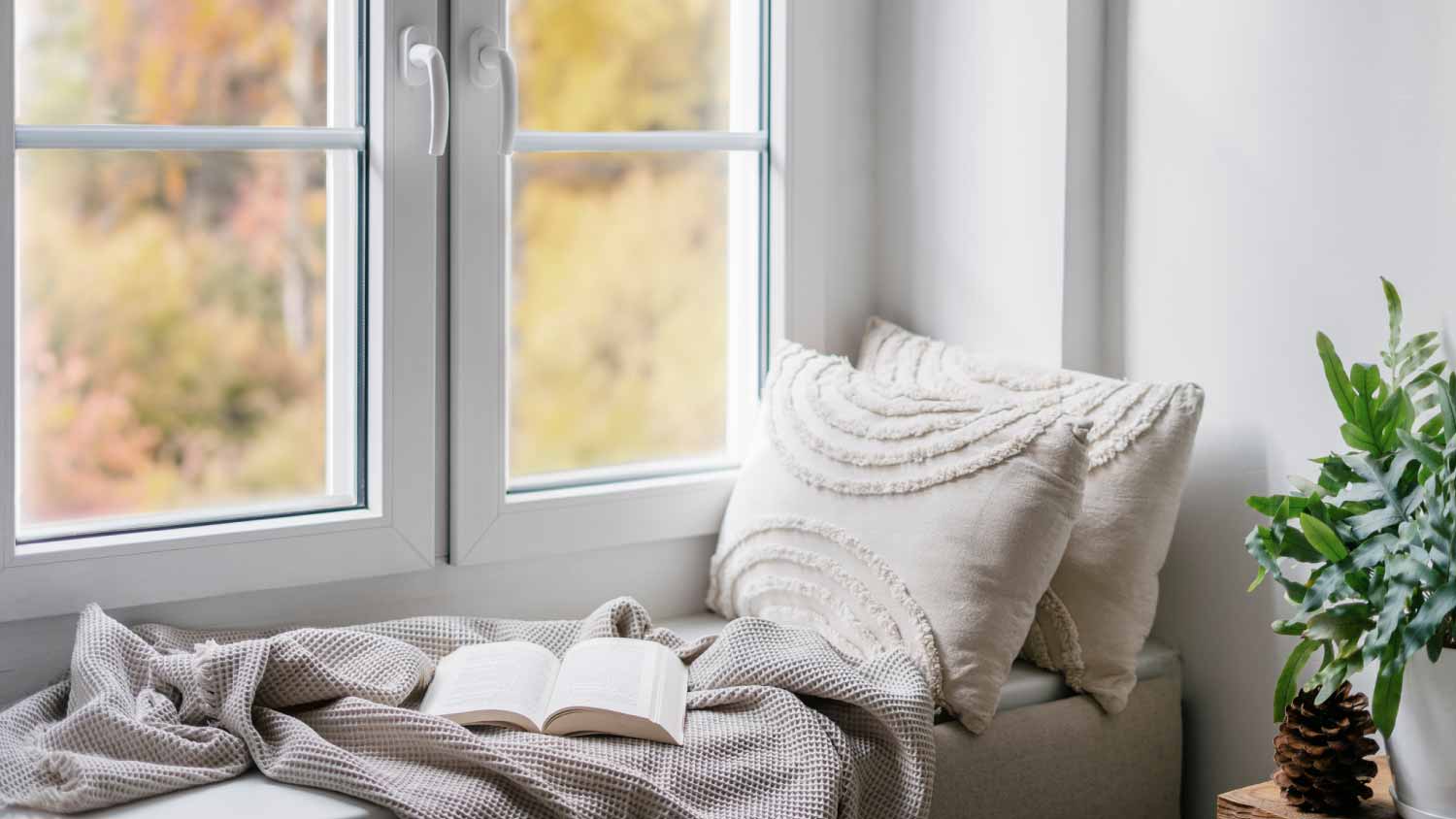
Learn how much triple-pane windows cost, exploring common cost factors such as their size, type, location in your home, and design.
Fiberglass is more durable and insulating but comes at a much higher cost


Fiberglass windows cost between $500 and $1,500.
Vinyl windows run between $100 and $900.
Fiberglass is a more environmentally friendly option.
Climate and your home’s energy efficiency are key considerations.
If you’re looking into buying or replacing windows, you might be wondering: which is better when it comes to vinyl vs. fiberglass windows?
Either material is a suitable choice for windows in most areas because they stand up to wind and rain while leaving you with easy maintenance. Vinyl windows, with a lower price point, are the most common choice, but fiberglass takes the trophy for eco-friendliness, insulation, and durability. In this guide, we’ll discuss what you should consider before buying new windows.
The biggest differences between vinyl and fiberglass windows are the price, the longevity, and the insulating value.
Vinyl windows are more popular because they cost significantly less, between $100 and $900 per window, while still providing good insulation and protection from the elements. Fiberglass windows are much more expensive at between $500 and $1,500 per window. However, it’s one of the most insulating window frame materials, making it a better option in extreme temperatures.
Additionally, while fiberglass windows are much more expensive, they last 30 to 50 years, whereas vinyl windows only last for 20 to 30 years.
Vinyl windows have frames and sashes made out of polyvinyl chloride (PVC), the same material you might find in drain pipes in your plumbing system or many privacy fences. Vinyl windows are a lightweight, affordable option for replacing old windows, but they may not last as long as fiberglass and often require more maintenance.
| Pros | Cons |
|---|---|
| Affordable | Not as insulating |
| Better insulation than aluminum | Can’t be painted |
| Available in different colors | Shorter lifespan |
Best For: Budget-friendly homeowners who want better insulation than they’d get from aluminum windows.
Common material: Vinyl windows are made from PVC (polyvinyl chloride), commonly found in many exterior home components like trim and siding. PVC is popular in home systems because it is a corrosive-resistant, all-purpose material that works well for different projects. It’s also widely available in different sizes and shapes.
Lower cost: A wallet-friendly up-front window replacement cost can make it easier to purchase a new window, especially if you have multiple windows to replace. Vinyl windows often cost about half as much as fiberglass windows.
Good value: Vinyl may not be as insulating as fiberglass, but it’s a better insulator than aluminum and comes at a much lower price than wood and fiberglass. This makes vinyl windows an excellent value.
Available in different colors: While you can’t paint vinyl windows, many manufacturers make them in different colors for some customization options.
Less durable: Vinyl’s overall durability comes up a bit short compared to fiberglass. It is prone to warping from moisture and extreme heat. It also lasts up to 20 years shorter than fiberglass as a result.
Less insulating: Vinyl isn’t as good of an insulator as fiberglass, so while it provides a good balance between upfront cost and efficiency, it won’t maintain your interior temperatures as well as fiberglass will.
Can’t easily be painted: You can get vinyl manufactured in different colors, but it’s difficult to paint afterward, unlike fiberglass.
More maintenance: With a more flexible frame, vinyl can also dry out over time and crack. Keeping your windows in good condition will likely require more frequent maintenance.
Fiberglass windows have frames and sashes made from fiberglass, which is a woven material that has small glass fibers embedded in it.Fiberglass windows offer better durability and energy efficiency than vinyl windows and can hold up for decades. However, they’re significantly more expensive.
| Pros | Cons |
|---|---|
| Outstanding insulator | Expensive |
| Customizable and paintable | Can fade over time |
| Excellent durability |
Best For: Homeowners with a large budget who want the best efficiency and a high-end curb appeal for their homes.
More durable: Fiberglass is a more durable material than vinyl, so it won’t crack or warp in response to extreme temperature fluctuations.
Outstanding efficiency: Fiberglass offers some of the best insulation when it comes to window frames. This makes it a stellar option for extreme climates where energy efficiency is of the utmost importance.
Longer lifespan: Fiberglass windows sometimes last for up to 50 years, about 20 years longer than vinyl windows. When it comes time to replace a window, a window company near you can provide replacement options and installation.
Expensive: The biggest downside to fiberglass windows, and likely the only reason they’re not the go-to choice for most homeowners, is the cost. They can run you up to about twice as much as vinyl windows.
Vulnerable to UV: While fiberglass windows can withstand dents, warping, and corrosion, they can be damaged by ultraviolet (UV) rays. If you live in a hot climate or don’t have a lot of tree covering in your yard, you might need to perform more frequent maintenance or painting to keep them looking good as new.
Vinyl and fiberglass windows differ in a few key ways, which we’ll discuss in the following sections to help you decide the best option for you.

Outside of price, different window materials have different levels of insulation and energy efficiency. A window pro can guide you through the different features to pick the best option for your budget.
From a distance, fiberglass and vinyl windows look pretty much the same, but there are some subtle differences to know. Both types can accommodate a variety of styles and colors from the manufacturer. You can paint fiberglass windows to match your house’s trim or even your patio decor if it changes over time. Vinyl, on the other hand, won’t take paint well—so choose your color carefully. Some manufacturers make vinyl and fiberglass windows look like wood by adding a texture to the material.
Overall, the two window frame materials are similar in their appearance, but fiberglass is a bit more customizable.
Fiberglass windows are more expensive than their vinyl counterparts. Expect to pay $500 to $1,500 for fiberglass, while vinyl windows cost $100 to $900. With that being said, fiberglass windows can last 20 years longer than vinyl ones, so the long-term cost differences is less severe. Still, vinyl windows are more affordable.
When it comes to the sizes and types of windows available with vinyl and fiberglass frames, you’re likely to get about the same from both frame materials. Many manufacturers make different window styles—like double-hung and single-hung windows—in numerous dimensions for flexibility and customization.
Another benefit of fiberglass windows is that they’re the more environmentally friendly option. While fiberglass is not easily recycled, it is often made from recycled glass. The manufacturing process puts less strain on the environment, as fewer chemicals are required during production.
Vinyl windows, on the other hand, put more strain on the environment to produce, but PVC is more easily recyclable, even though the quality of the plastic degrades as it moves further and further away from virgin plastic.
The last thing to consider when discussing the environmental impact of these window frame materials is their insulating value. Fiberglass does a better job of keeping outdoor temperatures outside where they belong, which can reduce your reliance on fossil fuels to heat and cool your living space.
All in all, since fiberglass is made from recycled material, lasts nearly twice as long, and better insulates your home, it’s fair to say it’s better for the environment.
Both vinyl and fiberglass windows are more durable than wood, which is vulnerable to rot, insects, and moisture. Though both vinyl and fiberglass are durable options, fiberglass is very strong and will stand up better to extreme temperature changes and impact. Vinyl can crack and warp after numerous temperature swings, and it won’t stand up as well to wind-blown debris, fallen tree limbs, or other impacts.
Ahh, neighbors. We love them, but we might not love their music choices and frequent backyard gatherings. If you have louder-than-average neighbors or live on a street you wish were quieter, you might want to spring for fiberglass windows, as they block noise much better than vinyl.
Basic housekeeping is going to be easy with either vinyl or fiberglass windows. They can both be wiped down with a towel and a little dish soap to stay streak- and dirt-free. After that, there are tradeoffs.
Vinyl can expand and contract in heat. Over time, this will cause the seal to weaken, so it will need to be re-caulked regularly. Make sure to check your windows for leaks about once a year. Fiberglass windows stand up to extreme weather better but might eventually fade and need to be painted. In the end, fiberglass is likely to be less labor-intensive and more affordable to maintain.
Lacy Brunnette contributed to this piece.
From average costs to expert advice, get all the answers you need to get your job done.

Learn how much triple-pane windows cost, exploring common cost factors such as their size, type, location in your home, and design.

A new arched window can boost curb appeal, home value, and energy efficiency. Learn how much arched windows cost and what factors to consider.

Wooden windows elevate a home’s curb appeal and have a lifespan of up to 45 years. Learn about the cost of wooden windows and how to get an estimate.

Want to know how long vinyl windows last? Learn the average lifespan of vinyl windows and the core factors that affect their performance over time.

Experienced DIYers can save money by replacing a window on their own. Here’s a step-by-step process for learning how to replace a window.

Window track repairs include replacing the wheel, cleaning the track, and lubricating the track. Read this how-to to learn how to fix your window track.